Growth Just Ate My Backlog!
Transitioning from Product Management to Growth.
"Growth is intertwined with product in the software world we live in - meaning it's hard to know where product ends and Growth begins." - Andrew McInnes.
Growth is now a very big deal. We're way past observing that 'the lines between Product and Marketing' are becoming blurred. In case you hadn't noticed, Growth just ate Marketing. And it just ate my backlog too. This post examines how Growth is changing Product Management as we know it and asks whether it will consume it entirely in the near future.
Why Growth changes everything for Product Managers
'Traditional' product development followed an established life
cycle. Tracking a path from a product's introduction to the market
to its eventual decline and withdrawal, it has a wavelike form that
most Product Managers will be familiar with. 
But we are not in 'traditional' times, we are at the dawn of a new age. Everyone is on the left-hand side of the curve, very few Product Managers are worrying about the impact of the Maturity phase. At least not yet. If Facebook is still in the Growth Phase (which technically it is), then most likely you are too.
Lest we forget, a startup (according to Paul Graham and his Y Combinator acolytes) is defined by its potential for explosive Growth; it's not just a 'new' company. Noah Kagan, a former Product Manager (subsequently fired) at Facebook, described how Mark Zuckerberg once enshrined Facebook's central goal:
"One day I took Mark into a conference room and told him I had a genius idea. We needed to make money at Facebook to be a "real" business that made serious profit.
For the most part, I was always concerned that we weren't making enough money and had to prove to outside skeptics that we could generate real revenue.
Mark pushed back. On a whiteboard he wrote the word, "GROWTH." He proclaimed he would not entertain ANY idea unless it helped Facebook grow by total number of 'users.'"
Growth is no longer the responsibility of marketers or even Growth Hackers outside the Product Team. It doesn't just mean 'Acquisition' or tactics at the top of the funnel. It's as fundamental as the product itself.
The internet has collapsed what used to be the biggest obstacle
to success (namely: distribution) and the consequence is
infinite choice. Getting your voice heard above the din of
competing products is arguably a bigger challenge than building
something great, and monetising in this environment has become
exponentially more difficult. This is why you need to be thinking
about your Growth Machine from the outset. While it's still
essential to have a great product if you want to win, it's no
longer enough 
With thanks to Ben Thompson / Stratechery.
Organising for Growth
Conventional wisdom dictates that Product Teams with more than one Product Manager tend to be organised either around channel or technology. So we find Product Managers for mobile, Product Managers for web or Product Managers for video publishing. Thanks to Andrew McInnes' excellent expose of the internal structures of Uber and Pinterest (amongst others), we get a glimpse of how the new Unicorns are organising for explosive Growth.
What matters these days is where you are on the customer journey. Are you a prospect with a vague awareness or a committed evangelist? Each moment matters . And each stage can be optimised for Growth. This reflects an evolving understanding of what constitutes 'the product'. By this definition, the product is the value delivered during each phase.
In one of the most entertaining (and most famous) explanations of Growth, Chamath Palihapitiya, who lead the Growth Team at Facebook between 2007 and 2011, cuts through the jargon (' growth constant k ', anyone?) and outlines the fundamentals of a Growth Machine:
"Growth starts with a deep understanding of product value and is about moving new users to the Aha! moment as quickly as possible, measurable in seconds."
It's no longer about channels: apps, websites or content type. These are not your product as they are not what your customer is buying. What they are buying is value measured either in utility or pleasure. Understanding that value is known as the 'Aha! moment' and communicating the Aha! moment is the central function of a Growth Machine. Aligning teams around this goal is what hypergrowth companies (like Uber or Pinterest, aping Facebook) are doing.

In his study, McInnes observes 2 structural Growth Models emerging: the Functional and the Independent.
Independent is the model preferred by Uber and
Facebook. In this instance the VP of Growth heads the team, reports
into the CEO and oversees product, marketing, engineering, design,
and data expertise working on both demand and supply side growth.
There are (at least) 2 different flavours of the Independent Model
but both are organised around the customer journey 
Notice how Product Managers align under phases of the customer journey as well as how Growth incorporates Retention, Revenue and Referral - basically the whole customer base; end to end. According to Uber, this model values speed and iteration as it enables the Growth Team to build strong feedback loops into the product.
The alternative is the Functional Model in which established VPs are given responsibility for Growth so must balance the demands of Growth against the competing demands of technical debt, user experience improvements and feature development.
The Functional Model empowers established VPs to assess whether Growth is coming at the expense of engagement by analysing user behaviour over time.
The Functional Model works best when the person who's ultimately responsible for the Growth metrics is datacentric and recognises that product is iterative and learning-driven. Pinterest, Twitter, LinkedIn, Dropbox, and BitTorrent use the Functional Model.
The most commonly observed tension that exists is between the desire to preserve overall product quality and the user experience against the demands of Growth. As McInnes reports:
"The tension between maintaining user experience and attaining powerful Growth metrics is the greatest challenge our contributors said they face in leading independent-growth teams."
So a Product Manager's role seems to evolve under these circumstances to that of sentinel: someone who protects the quality of the product experience in the face of an avalanche of initiatives aimed at acquiring new users at all costs.
If you can't beat them…
So will Product Managers inevitably end up working in Growth? Many see Growth as a natural career evolution from Product Management. When so much of the job is consumed by activities to support Growth, it's inevitable that Product Managers become very expert in Growth tactics along the way. Growth pioneers such as Naomi Ionita (ex-Evernote now at Invoice2Go) and Elliot Shmukler (ex-LinkedIn now at WealthFront) have followed this path.
Some, like Pinterest's Casey Winters, transitioned from marketing intoProduct and now oversee the most likely hybrid team of the future. Reference his team's description on LinkedIn:
"We are a cross-functional team of product managers, engineers, designers, and analysts responsible for growing the user base of Pinterest. We focus on driving traffic globally, converting that traffic into signups, logins, and app installs, and engaging existing Pinners with end to end experiences."
Growth is everyone's business: from the first moments of awareness to lifelong advocacy, and every stage in between. But Growth is not what you are selling. You are selling value as conveyed by a product. So, is Growth merely the flipside of product or is one destined to be a subset of the other? Only time will tell.
This post was originally published on pivot.uk.com.
source: https://medium.com/art-marketing/growth-just-ate-m...